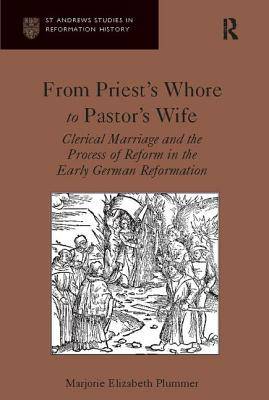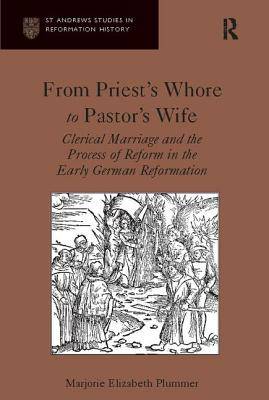
- Afhalen na 1 uur in een winkel met voorraad
- Gratis thuislevering in België vanaf € 30
- Ruim aanbod met 7 miljoen producten
- Afhalen na 1 uur in een winkel met voorraad
- Gratis thuislevering in België vanaf € 30
- Ruim aanbod met 7 miljoen producten
Zoeken
From Priest's Whore to Pastor's Wife
Clerical Marriage and the Process of Reform in the Early German Reformation
Marjorie Elizabeth Plummer
Paperback | Engels
€ 106,95
+ 213 punten
Uitvoering
Omschrijving
On 13 June 1525, Martin Luther married Katharina von Bora, a former nun, in a private ceremony officiated by city preacher Johann Bugenhagen. Whilst Luther was not the first former monk or Reformer to marry, his marriage immediately became one of the iconic episodes of the Protestant Reformation. From that point on, the marital status of clergy would be a pivotal dividing line between the Catholic and Protestant churches. Tackling the early stages of this divide, this book provides a fresh assessment of clerical marriage in the first half of the sixteenth century. It investigates the way that clerical marriage was received, and viewed in the dioceses of Mainz and Magdeburg under Archbishop Albrecht von Hohenzollern from 1513 to 1545. By concentrating on a cross-section of rural and urban settings from three key regions within this territory, Saxony, Franconia, and Swabia, the study is able to present a broad comparison of reactions to this contentious issue.
Specificaties
Betrokkenen
- Auteur(s):
- Uitgeverij:
Inhoud
- Aantal bladzijden:
- 368
- Taal:
- Engels
Eigenschappen
- Productcode (EAN):
- 9781138118492
- Verschijningsdatum:
- 22/05/2017
- Uitvoering:
- Paperback
- Formaat:
- Trade paperback (VS)
- Afmetingen:
- 155 mm x 231 mm
- Gewicht:
- 521 g

Alleen bij Standaard Boekhandel
+ 213 punten op je klantenkaart van Standaard Boekhandel
Beoordelingen
We publiceren alleen reviews die voldoen aan de voorwaarden voor reviews. Bekijk onze voorwaarden voor reviews.








